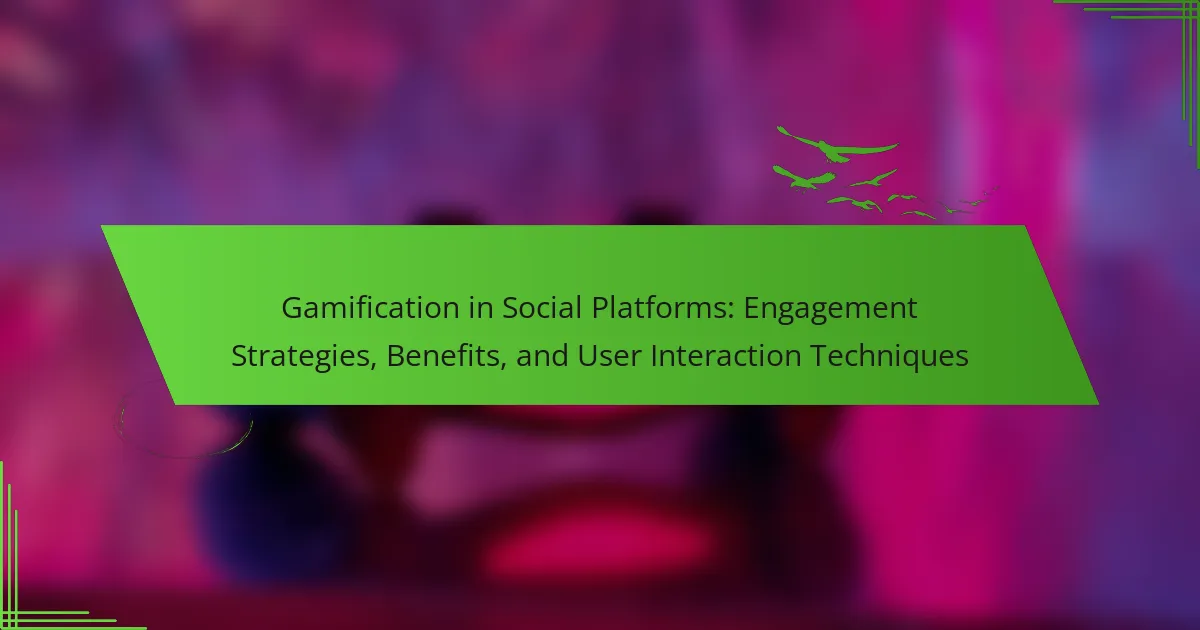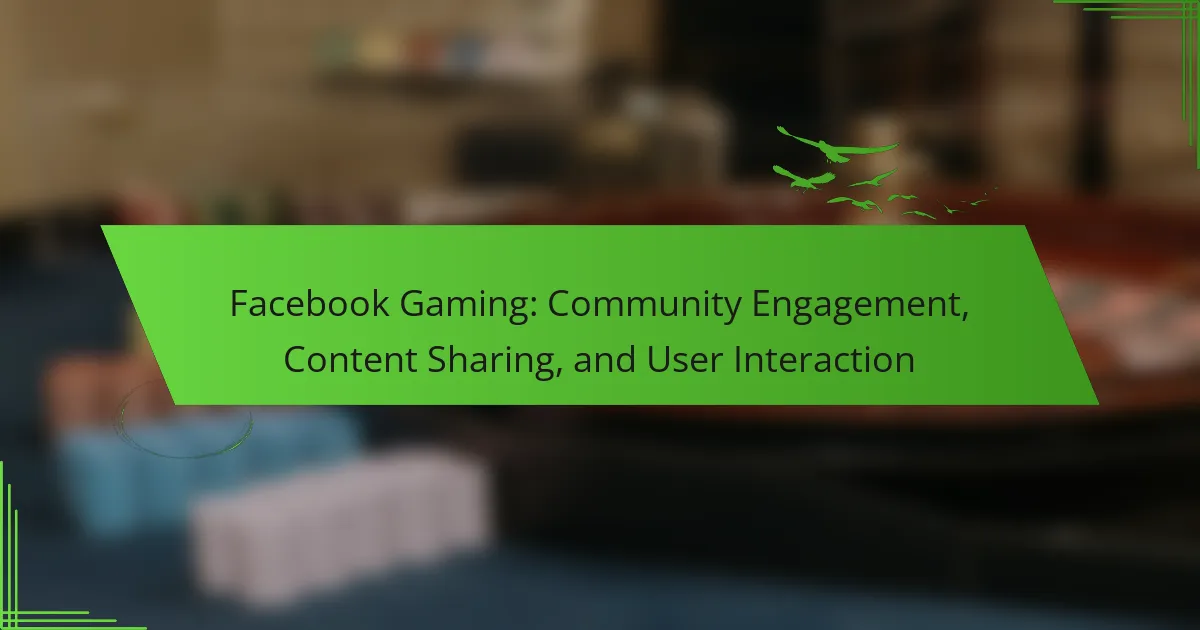Gamification in social platforms enhances user engagement through interactive elements. Key strategies include reward systems, competition through leaderboards, and social sharing features. These techniques foster motivation, build community, and drive platform growth. Understanding user preferences and measuring success with engagement metrics are essential for effective implementation.

What are the key engagement strategies in gamification for social platforms?
Gamification strategies in social platforms focus on enhancing user engagement through interactive elements. Key strategies include reward systems, competition, and social sharing features.
Reward systems incentivize users with points, badges, or levels, fostering motivation and loyalty. Competition elements, such as leaderboards, encourage users to engage more frequently to improve their rankings. Social sharing features enable users to showcase achievements, promoting community interaction and attracting new users.
These strategies not only enhance user experience but also drive platform growth and retention. By integrating these engagement techniques, social platforms can create a dynamic and interactive environment that keeps users invested.
How do reward systems influence user behavior in gamified environments?
Reward systems significantly enhance user behavior in gamified environments by providing motivation and feedback. They create a sense of achievement, encouraging users to engage more frequently. For instance, points, badges, and leaderboards foster competition and social interaction among users. As a result, these systems can lead to increased user retention and satisfaction. Research shows that gamification can boost engagement by up to 30%, highlighting its effectiveness in driving user behavior.
What role do leaderboards play in enhancing user interaction?
Leaderboards significantly enhance user interaction by creating competition and motivation among users. They provide tangible recognition for achievements, fostering a sense of accomplishment. This gamification strategy encourages users to engage more frequently, aiming to improve their rankings. As a result, platforms experience increased activity and community building, leading to higher overall user satisfaction.
Which types of challenges and quests are most effective in promoting engagement?
Challenges and quests that incorporate competition, rewards, and social interaction are most effective in promoting engagement. These elements create a sense of achievement and community among users.
For example, leaderboards encourage users to compete, while rewards such as badges or points incentivize participation. Social sharing features further enhance engagement by allowing users to showcase their achievements.
Additionally, time-sensitive challenges can drive urgency, motivating users to participate actively. Overall, integrating these strategies fosters a dynamic and interactive user experience on social platforms.
How can social sharing features amplify gamification efforts?
Social sharing features significantly enhance gamification efforts by increasing user engagement and interaction. These features encourage users to share achievements, fostering a sense of community and competition. As a result, platforms can leverage social dynamics to motivate users, driving participation and retention. Integration of leaderboards and shareable content amplifies visibility, attracting new users and enhancing overall platform activity. Additionally, social sharing creates opportunities for feedback and collaboration, enriching the user experience and deepening connections within the community.

What benefits does gamification bring to social platforms?
Gamification enhances user engagement on social platforms through interactive elements that motivate users. It fosters a sense of achievement, encourages participation, and builds community. Users experience increased satisfaction and retention, leading to longer interaction times. Additionally, gamification can drive user-generated content, enhancing platform vibrancy.
How does gamification improve user retention rates?
Gamification significantly enhances user retention rates by creating engaging experiences. By incorporating elements like rewards, challenges, and social interactions, platforms encourage users to return frequently. This dynamic fosters a sense of achievement and community, ultimately leading to increased loyalty. For example, platforms that utilize point systems or leaderboards see higher participation and prolonged user sessions.
What impact does gamification have on user-generated content?
Gamification significantly enhances user-generated content by increasing engagement and interaction. It encourages users to participate actively through rewards, challenges, and recognition, fostering a sense of community.
Gamification strategies can lead to higher content quality as users are motivated to create and share their best work. For example, platforms often implement points systems or badges to incentivize contributions. This can result in a more vibrant and dynamic user environment.
Moreover, gamification can improve retention rates. Users are more likely to return to platforms where they feel rewarded for their contributions. As a result, this creates a feedback loop that continuously boosts user-generated content.
In summary, gamification impacts user-generated content by enhancing engagement, improving quality, and increasing retention, ultimately benefiting social platforms.
How can gamification enhance brand loyalty among users?
Gamification enhances brand loyalty by fostering user engagement through interactive experiences. By incorporating game-like elements, brands create a sense of achievement, encouraging users to interact more frequently. This strategy increases emotional connection, as users feel rewarded for participation. Additionally, gamification can drive competition among users, further enhancing loyalty through social interaction. Brands that utilize these techniques often see improved retention rates and customer satisfaction.

Which unique techniques are used in gamification across different platforms?
Gamification techniques across social platforms include points, badges, leaderboards, and challenges. These strategies enhance user engagement and interaction, fostering a sense of achievement.
1. Points: Users earn points for completing tasks, promoting participation.
2. Badges: Visual rewards signify accomplishments, encouraging continued effort.
3. Leaderboards: Rankings motivate competition among users, driving engagement.
4. Challenges: Time-limited tasks create urgency, enhancing interaction and retention.
5. Social sharing: Users share achievements, expanding reach and community involvement.
6. Feedback loops: Instant feedback on actions reinforces behavior and enhances user experience.
How do cultural differences influence gamification strategies in various regions?
Cultural differences significantly shape gamification strategies across regions by influencing user motivations and preferences. For instance, collectivist cultures may prioritize community engagement features, while individualistic cultures might favor personal achievement metrics. These variations require tailored approaches to enhance user interaction and satisfaction. Understanding local customs, values, and communication styles allows platforms to create more effective gamification elements that resonate with diverse audiences. As a result, businesses can improve user retention and engagement by aligning their strategies with cultural expectations.
What innovative formats have emerged in gamified interactions?
Innovative formats in gamified interactions include interactive storytelling, augmented reality experiences, and live competitions. These formats enhance user engagement by providing immersive experiences. For instance, interactive storytelling allows users to influence narratives, while augmented reality blends digital elements with the real world. Live competitions foster community participation and real-time interaction, driving user retention and enjoyment.
How do augmented reality elements enhance user engagement in social platforms?
Augmented reality elements significantly enhance user engagement in social platforms by creating immersive experiences. These elements enable interactive content, allowing users to participate actively rather than passively consuming information. For example, AR filters on platforms like Instagram and Snapchat encourage users to create and share personalized content, fostering a sense of community.
Additionally, gamification techniques, such as rewards for using AR features, motivate users to engage more frequently. This strategy not only increases time spent on the platform but also encourages social sharing. As a result, user interaction techniques that incorporate augmented reality lead to higher satisfaction and loyalty among users.

What are the common challenges faced in implementing gamification?
Common challenges in implementing gamification include lack of clear objectives, insufficient user engagement, and inadequate technical infrastructure. Organizations often struggle to define specific goals for gamification, leading to ineffective strategies. Additionally, users may not respond positively if the gamification elements do not resonate with their interests or motivations. Lastly, technical limitations can hinder the integration of gamification features into existing platforms, impacting overall effectiveness.
How can platforms overcome user resistance to gamified elements?
Platforms can overcome user resistance to gamified elements by prioritizing user experience and providing clear value. Fostering a sense of community through social interactions can enhance engagement. Personalization of gamified features makes them more relevant and appealing. Additionally, transparent communication about the benefits and mechanics of gamification can alleviate user concerns. Offering rewards that resonate with users’ interests can also encourage participation.
What are the pitfalls of poorly designed gamification strategies?
Poorly designed gamification strategies can lead to disengagement and frustration among users. These pitfalls include lack of clear objectives, overcomplicated mechanics, and insufficient rewards. Users may feel overwhelmed if the gamification elements are too complex, leading to confusion rather than engagement. Additionally, if rewards are not meaningful or aligned with user goals, motivation can diminish. Finally, neglecting user feedback can result in strategies that fail to resonate, ultimately harming user interaction on social platforms.

What metrics should be used to measure the success of gamification initiatives?
To measure the success of gamification initiatives, focus on user engagement, retention rates, and satisfaction scores. These metrics provide clear insights into how effectively gamification strategies enhance user interaction and overall experience.
| Metric | Description | Value Type |
|————————-|————————————————–|——————-|
| User Engagement | Frequency of user interactions with gamified elements | Quantitative |
| Retention Rate | Percentage of users returning after initial engagement | Percentage |
| Satisfaction Score | User feedback ratings on gamified experiences | Qualitative |
| Task Completion Rate | Ratio of completed tasks to total tasks presented | Percentage |
| Social Sharing | Number of times users share content on social platforms | Quantitative |
| Conversion Rate | Percentage of users completing desired actions | Percentage |
Which data points are most indicative of user engagement levels?
User engagement levels are most indicative through metrics like active users, session duration, and interaction rates. Active users reflect participation frequency, while session duration measures time spent on the platform. Interaction rates indicate user responsiveness to gamified elements. These data points collectively highlight the effectiveness of engagement strategies in gamification.
How can platforms analyze user feedback to refine gamification efforts?
Platforms can analyze user feedback to refine gamification efforts by employing data analytics and user surveys. This approach helps identify engagement patterns and user preferences.
Analyzing user feedback allows platforms to adjust game mechanics, rewards, and challenges based on real user experiences. For example, if users express dissatisfaction with certain features, platforms can modify them to enhance satisfaction.
Utilizing metrics such as user retention rates and interaction frequency can provide insights into which gamification elements are effective. As a result, platforms can prioritize enhancements that drive user engagement and satisfaction.
Incorporating A/B testing can also facilitate the refinement process. By comparing different gamification strategies, platforms can determine which versions resonate most with users, ensuring continuous improvement in engagement strategies.
What tools are available for tracking gamification effectiveness?
Various tools are available to track gamification effectiveness on social platforms. These tools include analytics software, user feedback systems, and engagement metrics dashboards. Analytics software like Google Analytics tracks user interactions and engagement levels, providing insights into how gamification elements influence user behavior. User feedback systems gather qualitative data, allowing platforms to assess user satisfaction and areas for improvement. Engagement metrics dashboards visualize key performance indicators, helping to identify trends and measure the overall impact of gamification strategies.

What best practices should be followed for effective gamification?
To achieve effective gamification in social platforms, focus on clear objectives, user-centric design, and continuous feedback. Engaging users requires understanding their motivations and preferences, which enhances interaction and retention.
Incorporate elements such as point systems, badges, and leaderboards to create a competitive yet rewarding environment. These features promote user engagement and foster community building.
Regularly analyze user behavior to refine strategies and ensure the gamified experience aligns with user expectations. This iterative approach helps maintain interest and encourages ongoing participation.
Lastly, consider integrating social sharing options to amplify user achievements, enhancing visibility and encouraging more users to engage with the platform.
How can platforms ensure inclusivity in gamified experiences?
Platforms can ensure inclusivity in gamified experiences by prioritizing diverse user needs and feedback. Implementing adaptive design accommodates various abilities and preferences. Offering multiple engagement methods, such as visual, auditory, and kinesthetic options, enhances accessibility. Regularly updating content based on user interaction data fosters a welcoming environment. Additionally, involving underrepresented groups in the design process ensures their perspectives are integrated, promoting a sense of belonging.
What are the key elements of a successful gamification strategy?
A successful gamification strategy incorporates clear objectives, engaging mechanics, user feedback, and measurable outcomes. These elements enhance user interaction and drive long-term engagement on social platforms.
Clear objectives define the purpose of gamification, guiding design and implementation. Engaging mechanics, such as challenges and rewards, motivate users to participate actively. User feedback allows for continuous improvement, ensuring the experience remains relevant and enjoyable. Finally, measurable outcomes help assess the effectiveness of the strategy, allowing for data-driven adjustments.
These components work together to create a dynamic environment that fosters user loyalty and interaction.
How can continuous improvement be integrated into gamification efforts?
Continuous improvement can enhance gamification by fostering user engagement and refining strategies. Implementing feedback loops allows platforms to adapt features based on user interactions. Regularly analyzing user data helps identify trends and preferences, leading to tailored experiences. For example, integrating reward systems can motivate users to participate more actively. This iterative process ensures that gamification efforts remain relevant and effective, ultimately improving user satisfaction and retention.



